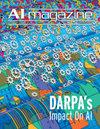可解释人工智能(XAI):医疗保健领域的概念和挑战
IF 2.5
4区 计算机科学
Q3 COMPUTER SCIENCE, ARTIFICIAL INTELLIGENCE
引用次数: 9
摘要
人工智能(AI)描述了能够执行通常需要人类智能的任务的计算机系统,例如视觉感知、语音识别、决策和语言翻译。人工智能技术的例子有机器学习、神经网络和深度学习。人工智能可以应用于许多不同的领域,如计量经济学、生物计量学、电子商务和汽车行业。近年来,人工智能也进入了医疗保健领域,帮助医生做出更好的决定(“临床决策支持”),在磁共振图像中定位肿瘤,阅读和分析放射科医生和病理学家写的报告,等等。然而,人工智能有一个很大的风险:它可能被视为一个“黑匣子”,限制了人们对其可靠性的信任,这在一个决定可能意味着生死的领域是一个非常大的问题。因此,术语“可解释人工智能”(XAI)得到了发展势头。XAI试图确保人工智能算法(以及由此产生的决策)能够被人类理解。在这篇叙述性综述中,我们将介绍XAI中的一些核心概念,描述XAI在医疗保健领域面临的几个挑战,并讨论它是否真的可以帮助医疗保健向前发展,例如,通过增加理解和信任。最后,讨论了增加对人工智能信任的替代方案,以及未来在XAI领域的研究可能性。本文章由计算机程序翻译,如有差异,请以英文原文为准。
Explainable Artificial Intelligence (XAI): Concepts and Challenges in Healthcare
Artificial Intelligence (AI) describes computer systems able to perform tasks that normally require human intelligence, such as visual perception, speech recognition, decision-making, and language translation. Examples of AI techniques are machine learning, neural networks, and deep learning. AI can be applied in many different areas, such as econometrics, biometry, e-commerce, and the automotive industry. In recent years, AI has found its way into healthcare as well, helping doctors make better decisions (“clinical decision support”), localizing tumors in magnetic resonance images, reading and analyzing reports written by radiologists and pathologists, and much more. However, AI has one big risk: it can be perceived as a “black box”, limiting trust in its reliability, which is a very big issue in an area in which a decision can mean life or death. As a result, the term Explainable Artificial Intelligence (XAI) has been gaining momentum. XAI tries to ensure that AI algorithms (and the resulting decisions) can be understood by humans. In this narrative review, we will have a look at some central concepts in XAI, describe several challenges around XAI in healthcare, and discuss whether it can really help healthcare to advance, for example, by increasing understanding and trust. Finally, alternatives to increase trust in AI are discussed, as well as future research possibilities in the area of XAI.
求助全文
通过发布文献求助,成功后即可免费获取论文全文。
去求助
来源期刊

Ai Magazine
工程技术-计算机:人工智能
CiteScore
3.90
自引率
11.10%
发文量
61
审稿时长
>12 weeks
期刊介绍:
AI Magazine publishes original articles that are reasonably self-contained and aimed at a broad spectrum of the AI community. Technical content should be kept to a minimum. In general, the magazine does not publish articles that have been published elsewhere in whole or in part. The magazine welcomes the contribution of articles on the theory and practice of AI as well as general survey articles, tutorial articles on timely topics, conference or symposia or workshop reports, and timely columns on topics of interest to AI scientists.
 求助内容:
求助内容: 应助结果提醒方式:
应助结果提醒方式:


